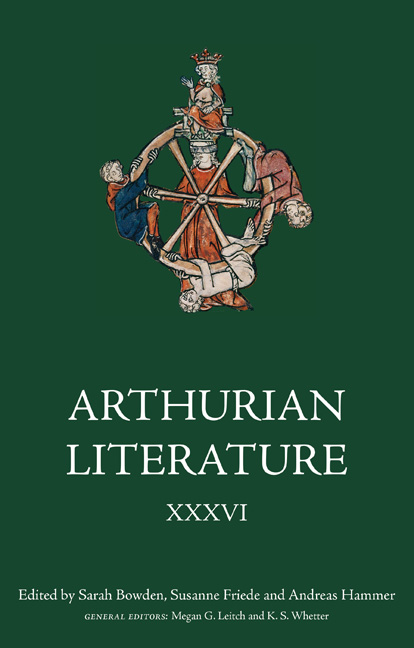Book contents
- Frontmatter
- Contents
- General Editors’ Preface
- List of Contributors
- Introduction: Sacred Space and Place in Arthurian Romance
- 1 The Church and the Otherworld: Sacred Spaces in the Matière de Bretagne and Medieval Ireland
- 2 Sacred Spaces: the Syntagmatic and Paradigmatic Construction of Narrated Space in Chrétien’s Conte du Graal
- 3 Perceiving the Way: Sacred Spaces and Imaginary Pilgrimage in the Vulgate Cycle Queste del Saint Graal and Thomas Malory’s ‘Tale of the Sankgreal’
- 4 Affirming Absence and Embracing Nothing: on the Paradoxical Place of Heterosexual Sex in Medieval French Verse Romance
- 5 Spaces of Remorse: Penitential Allusions in Iwein
- 6 The Spatial Narratives of Salvation and Damnation in Wigalois and the Prose Lancelot
- 7 ‘Fantoum and Fayryȝe’: Visions of the End of Arthurian Britain
- 8 The Tomb of the Kings: Imperial Space in Arthur’s Camelot
- Contents of Previous Volumes: Details of Earlier Titles are Available from the Publishers
8 - The Tomb of the Kings: Imperial Space in Arthur’s Camelot
Published online by Cambridge University Press: 17 April 2021
- Frontmatter
- Contents
- General Editors’ Preface
- List of Contributors
- Introduction: Sacred Space and Place in Arthurian Romance
- 1 The Church and the Otherworld: Sacred Spaces in the Matière de Bretagne and Medieval Ireland
- 2 Sacred Spaces: the Syntagmatic and Paradigmatic Construction of Narrated Space in Chrétien’s Conte du Graal
- 3 Perceiving the Way: Sacred Spaces and Imaginary Pilgrimage in the Vulgate Cycle Queste del Saint Graal and Thomas Malory’s ‘Tale of the Sankgreal’
- 4 Affirming Absence and Embracing Nothing: on the Paradoxical Place of Heterosexual Sex in Medieval French Verse Romance
- 5 Spaces of Remorse: Penitential Allusions in Iwein
- 6 The Spatial Narratives of Salvation and Damnation in Wigalois and the Prose Lancelot
- 7 ‘Fantoum and Fayryȝe’: Visions of the End of Arthurian Britain
- 8 The Tomb of the Kings: Imperial Space in Arthur’s Camelot
- Contents of Previous Volumes: Details of Earlier Titles are Available from the Publishers
Summary
When Arthur comes to the throne in Thomas Malory's Morte Darthur, his rule is challenged (as in some of Malory's sources) by forces both external and internal. In Malory, the internal resistance comes in two waves, related but in a slightly unclear way: an initial rebellion at his coronation by kings angry at the accession of ‘a berdles boye that was come of lowe blood’ (12.9–10), and a second following an act of political infanticide combined with an invasion from North Wales. This Welsh invasion is led by Ryons of North Wales and his brother Nero now in alliance with Lot of Lothian and the Orkneys (Lot being a driving force in the initial rebellion). After the final defeat of this combined force, Arthur orders the erection of a grandiose monument both to his victory and to the memories of the dead:
But of all the twelve kyngis Kynge Arthure lette make the tombe of Kynge Lotte passynge rychely, and made hys tombe by hymselff.
And than Arthure lette make twelve images of laton and cooper, and overgylte with golde in the sygne of the twelve kynges, and eche one of hem helde a tapir of wexe in hir honde that brente nyght and day. And Kynge Arthure was made in the sygne of a fygure stondynge aboven them with a swerde drawyn in hys honde, and all the twelve fygures had countenaunce lyke unto men that were overcom. All thys made Merlion by hys subtyle craufte. (62.2–11)
The reconciliation between Lot and Arthur, found in previous versions (as discussed below), is here replaced by unity through elimination, caught in an image of conquest and domination. The description of the tombs stands out in a Camelot otherwise only faintly sketched: we know more about this aspect of St Stephen's Cathedral, where this tomb is located (61.30–31), than any other physical location in the Morte.
In this essay, I will argue that this monument is far more important to Malory's over-arching purpose than has been previously acknowledged: its spatial location, at the heart of Arthur's most famous castle, anchors Arthurian claims to control over the various kingdoms and regions which make up his empire.
- Type
- Chapter
- Information
- Arthurian Literature XXXVISacred Space and Place in Arthurian Romance, pp. 175 - 192Publisher: Boydell & BrewerPrint publication year: 2021



